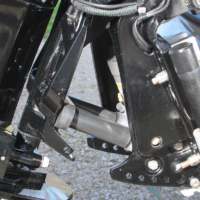I was looking for info on what the difference was between using the traditional transom saver that spans between the lower unit of the boat motor and the boat trailer and the units that fit between the motor and the Trim and Tilt Cylinders.. I was seeing the company that is making the product from #DD26Fishing products so I reached out to them for their input and I was very impressed with their response so I thought I would share ..
DD26 Fishing,
I have been seeing your DD26 motor mounts and I am curious how they are better on the transom then the transom saver I have used for years ? I have a 619 Ranger DVS with a 225 Pro XS… I am always concerned out protecting my motor and transom so I have always used the traditional transom saver… I look forward to your reply…. Oh… I have just repowered my Ranger with a 2020 225 Pro XS 4 Stroke…
I look forward to your response….Dave Koonce
Hi Dave, thanks for reaching out. Let me first start by saying you’ll see guys that swear by the trailer to lower unit method. Then you’ll see guys that swear by the motor tote method. Both are right and both are wrong. My job isn’t to lie to anyone. There is no perfect solution, but the idea is to try and reduce blunt force movement in both applications. With the lower unit to trailer solution, the trailer acts as a brace to keep the lower unit from hard downward forces. The challenge with that is the engine is held up while the force of the transom still has downward and backward motion. So the transom, hull engine and trailer and not necessarily moving as one. They are working against each other in many aspects. This does put stress on multiple parts of the boat set up. Also, many of the crossmembers on the trailers actually flex up to 6-8 inches. That again allows different parts of the boat/motor/trailer to stress against each other. (trim down more than you normally might once with that type of transom saver and watch the cross member with the roller. Does it stay stationary? Yours may or may not depending on the type of trailer, but most flex more than you think, hence the reason you have to strap it on so it does not fall off. When you hit a bump it flexes and then the engine bounces up and it pops out. That method does provide a level of limiting the downward force which is good thing, but as you can see, not perfect either. Additionally that type does unfortunately wear on your lower unit a bit and can cause some issues there too. The Motor Tote version like ours also has good and bad. The key thing with ours is getting all pieces from Trailer/transom/hull/engine to try to move as one. By keeping all parts as unified as possible, your trailer actually becomes the best possible shock absorber there is. Most guys don’t pay enough attention, but the tire pressure is one of the best ways to protect your boat no matter which method you choose. Our unit has automotive grade bump stops that absorb impact and downward force. They are the same material and type that keep your gas tank from smashing up into your truck frame. That’s a huge stress relief as well. The motor totes also have a circular force if you will. When the engine wants to move downward, the base of the motor tote diverts that force back towards the transom which neutralizes the original backward pull on the transom. That’s a big deal. That’s where the guys who say, it’s not a transom saver, it does nothing are 100% wrong. Physics not opinion on that one, dead wrong. It does help reduce force. If you think about it in this stupid analogy, take a carton of eggs. Tape it up so the carton can only move as one piece. Strap it down securely to your trailer. When you drive the trailer will absorb almost all the impact and your eggs will survive better than you think. Now take the carton, don’t shut the lid all the way, don’t strap it down and see how it does when all pieces are not moving as one…… Stupid but very true in terms of the importance and benefit of all pieces being secured, letting the trailer buffer the impact instead of the pieces working freely and/or against each other.
Bottom line, there isn’t a perfect solution and probably won’t ever be, but your boat/hull/transom takes a tremendous amount of pressure out on the water. Think about the impact when you go airborne and we’ve all been there. The fiberglass is flexing, the engine is being grabbed extremely abruptly and there is major force on the transom. If you can keep things stable and unified on your trailering set up, you’ve greatly reduced your stress to much less than your boat takes in the water. We’ve worked with the engine companies, the boat companies and in all honest there is only one person that hasn’t said that ours are some of the best they have even seen and recommend. That one person has a vested interest in another solution……. So, honest answer, there isn’t a perfect solution, but keeping things locked down as one unit is a big plus. Your boat will move slightly on your trailer, again with the trailer to lower unit method, that’s not a good thing with it pushing your engine upward wearing on your hydraulics. With ours that movement is uneventful and non-impactful. Sorry for the book, but you asked and there isn’t a simple explanation. Hope this help and you appreciate the honest response.
September 25, 2020 at 8:41 am
#1975237

